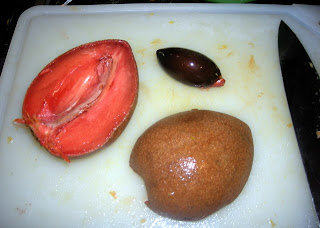 I was worried that I had waited too long, but after cutting one open, the consistency seemed just right. You can see the brilliant orange color in the photos. The taste and texture is very much like smooth, cooked, and highly sweetened pumpkin but just a little fruitier. Tropical Fruit Nursery describes sapote as having "the flavor and texture of sweet potato pudding".
I was worried that I had waited too long, but after cutting one open, the consistency seemed just right. You can see the brilliant orange color in the photos. The taste and texture is very much like smooth, cooked, and highly sweetened pumpkin but just a little fruitier. Tropical Fruit Nursery describes sapote as having "the flavor and texture of sweet potato pudding".In the reading I've done about sapote, it is most often recommended to be eaten fresh or in milk shakes. I haven't tried milk shakes yet but after tasting it, I am 100% certain that sugar would not have to be added. This fruit, without a doubt, was the sweetest fruit I have ever tasted.
It seems to me that sapote would make an excellent pumpkin-like pie with no added sugar. I'm wondering if the fruit would hold up to baking like pumpkin since I haven't seen it recommended for pies. I suppose you could make a no-bake pie with it.
 One thing that I have to warn about sapote. Some (a few) people have bad reactions to the fruit − extreme abdominal cramps. It turns out that I am one of those people. I would suggest that if you haven't tried sapote before, start with only, say, 1/4 of the fruit to see if you have a reaction.
One thing that I have to warn about sapote. Some (a few) people have bad reactions to the fruit − extreme abdominal cramps. It turns out that I am one of those people. I would suggest that if you haven't tried sapote before, start with only, say, 1/4 of the fruit to see if you have a reaction.I originally thought I had just overindulged, eating both the sapote and papaya at the same time. The next day, I just had the sapote but the same thing happened. The pain didn't last too long, and you know what? The zapote was worth it. ;-D In some countries, the fruit is also eaten to treat intestinal parasites. Could my problem have been from the good sapote battling bad parasites in my gut? Yuck. Could be.
I read a good tip about how to tell when sapote should be picked from the tree since it is picked when it is still rock-hard. Fruit picked too early, they say, will never develop properly. Scratch the surface of the rough, woody skin with your fingernail. If the skin beneath is pinkish, it is ready. If the skin is still green, it should be left on the tree for more time. The same tip could be used at the market. If the skin isn't pinkish underneath, don't buy it.
 Trees can be planted from the seeds, but it must be done quickly as the seed loses viability in a matter of days. I saved this seed, not to plant, but just because it is so interesting. It is a shiny brownish black with a wedge that does not have the shiny covering. The color has faded over time.
Trees can be planted from the seeds, but it must be done quickly as the seed loses viability in a matter of days. I saved this seed, not to plant, but just because it is so interesting. It is a shiny brownish black with a wedge that does not have the shiny covering. The color has faded over time.Another interesting tidbit is that here in northern Honduras, the fruit of the Pouteria sapota (Jacq.) tree is called Zapote and the fruit of Mammea americana is called Mamey. In other parts of Central America and South America, the fruit we call zapote is sometimes called mamey. According to CURLA's (the national agricultural university here in La Ceiba) tropical fruit book, the common name for Pouteria sapote in Mexico is mamey; in Panamá, mamey de tierra; in Puerto Rico, mamey rojo; and in Columbia and Ecuador, mamey colorado. However, the name zapote colorado is also used in Mexico and Colorado and to confuse matters even more, in some areas it is called mamey sapote.
For more on Sapote, see:
Tropical Fruits for Warm Climates (Purdue)- everything you ever wanted to know about sapote; this is one of my favorite references for tropical fruit trees.
Tropical Fruit Nursery - beautiful photos and some information about the fruit.



 Welcome to my Blogicito —
Welcome to my Blogicito — 







